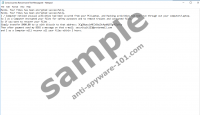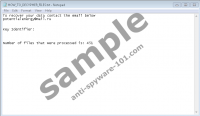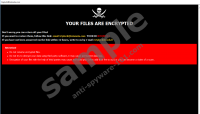RegretLocker Ransomware is a malicious computer infection that wants to rip you off. It tries to do that by holding your files hostage, hoping that you will pay a ransom for the locked files. If you don’t have a file backup, this situation can be really scary. But no matter how desperate you might get; you should never send your money to these cybercriminals. You should focus on removing RegretLocker Ransomware from your system, and then employing various security measures that can stop ransomware from entering your computer again. Read more »
Trojans - Page 3 category archyve:
Epor Ransomware
Epor Ransomware appends the .epor extension to the files that it enciphers. Thus, you can tell whether you have this infection on your device by looking at the titles of your photos, documents, and other personal files targeted by this malicious application. As a result, files become locked and cannot be opened. If you want to know more about what happens if you receive this vicious threat, we invite you to read our full report. At the end of it, you can also find our deletion instructions that explain how users who wish to delete Epor Ransomware can do so manually. The process might be tricky, which is why we recommend employing a legitimate antimalware tool that could eliminate the malicious application for you. Read more »
Consciousness Ransomware
Consciousness Ransomware is a malicious application that might encrypt files available on an infected device. Our researchers say that if the malware encrypts files, they should be marked with the. consciousness extension, for example, roses.jpg.consciousness. However, the tool might not encrypt anything, as our researchers came across a variant that only displayed a ransom note. You can learn more about the malware and the note it should show if you read the rest of this article. If you want to learn how the threat could be erased, you could check the instructions available at the end of this article. They show how to look for the malicious application’s data and how to erase it manually. Of course, the malware can be removed with a legitimate antimalware tool too. All you have to do is pick a reliable tool and do a full scan of your system. Read more »
Energy Ransomware
Energy Ransomware is a regular computer infection that can easily lock up your files. This program was designed to hold your files hostage until you contact the people behind it and pay the ransom fee. However, paying the ransom would not solve anything because you would only allow these criminals to create more programs that would terrorize other users worldwide.
Follow the guidelines below to get rid of Energy Ransomware, and don’t forget to invest in a licensed security application that would help you protect your system from other similar programs. Your system’s security should be one of your top priorities. Read more »
Aieou Ransomware
It has been proven many times before that acting carelessly can lead to the invasion of malware. Aieou Ransomware is a malicious infection that you might be tricked into executing when you open files and links sent via spam emails, or when you download files and programs presented via unreliable file-sharing websites. In general, if your system is not protected, it is automatically vulnerable, and all kinds of actions could open security backdoors, through which cybercriminals can drop malware easily. So, if you are currently trying to delete Aieou Ransomware, note that the elimination of this threat is not the only problem you have. You also need to figure out how to secure your operating system. Do not worry if you think you have a lot to deal with. In fact, securing your system and removing malware can be done simultaneously. Are you interested in that? Keep reading to learn about the findings of our Anti-Spyware-101.com research team, and do not hesitate to use the comments section if you have questions. Read more »
V3JS Ransomware
V3JS Ransomware is a malicious application that shows a warning with a picture of a skull. The malware does so after encrypting all victims’ images, text files, and data alike. As a result, the files that get encrypted become unusable. According to the threat’s ransom note, they can still be restored if a user pays a ransom, but you cannot be sure that it will happen. In other words, you could be tricked. Naturally, if you do not trust the malware’s creators and worry that they could deceive you, we advise you not to pay the ransom but concentrate on the malicious application’s deletion. To learn more about it, you could read our full article. Also, you may want to check the instructions available at the end of this article as they show how to remove V3JS Ransomware manually. Read more »
CC1H Ransomware
CC1H Ransomware belongs to the Globe Imposter Ransomware family. It means that the application is one of many that were based on the mentioned threat, and, as a result, it works very similarly. To learn more about its behavior and what to expect if you receive it, we invite you to read the rest of this article. For users who came here to learn how to delete CC1H Ransomware, we can offer our removal instructions available at the end of the text. They show how users might be able to erase the threat manually. It might not be an easy task even with the help of our recommended steps, in which case, we advise employing a legitimate antimalware tool that would help you get rid of the malicious application faster. If you have any questions, you can leave us a message in the comments area available below. Read more »
Iiss Ransomware
If you have time to secure your Windows operating system against Iiss Ransomware, make use of it. This dangerous infection can be extremely painful to deal with because it can successfully encrypt every single personal file found on the corrupted system. That includes work presentations, projects, and documents, as well as personal photos or videos. Perhaps you could restore some of them from your work computer, using your own backups, or with the help of colleagues, friends, and family, who might have their own copies. However, if you are unable to replace the encrypted files, you might be unable to get them back in any other way. Should you not purchase a file decryptor offered by the cybercriminals behind this malware? Anti-Spyware-101.com researchers suggest that you should not. What we recommend figuring out instead is how to delete Iiss Ransomware. Although this malware does not seem to repeat encryption attacks, you want to remove it as soon as possible. Read more »
Foqe Ransomware
If you were unable to keep your system protected against Foqe Ransomware, you must now be dealing with very uncomfortable consequences. If it is your work computer that was infected, you might have put your entire organization at risk, and you might have lost extremely important documents and other files. And if it is your home computer that was attacked, you might be facing a total encryption of photos, videos, audio files, and other personal files that are near and dear to your heart. In either case, facing this malware is no walk in the park, and even if you realize that it did not really encrypt anything important, you still have to figure out how to remove it. Anti-Spyware-101.com research team has analyzed this threat, and we can now help you learn more about it and also its elimination. So, are you ready to delete Foqe Ransomware? Read more »
LCK Ransomware
No one really notices the exact moment things like LCK Ransomware reach them. Ransomware programs hide in plain sight because users download and execute the installer files themselves. They often do not realize that they open a file that will install something like LCK Ransomware on their computer because they are not aware of ransomware distribution methods. Hence, let’s learn more about how ransomware spreads, and let’s remove LCK Ransomware from the infected systems immediately. When we’re done with that, let’s see what we can do about your encrypted files. Read more »











